technical data Seat Altea 2010 Owner's Manual
[x] Cancel search | Manufacturer: SEAT, Model Year: 2010, Model line: Altea, Model: Seat Altea 2010Pages: 310, PDF Size: 7.46 MB
Page 281 of 310
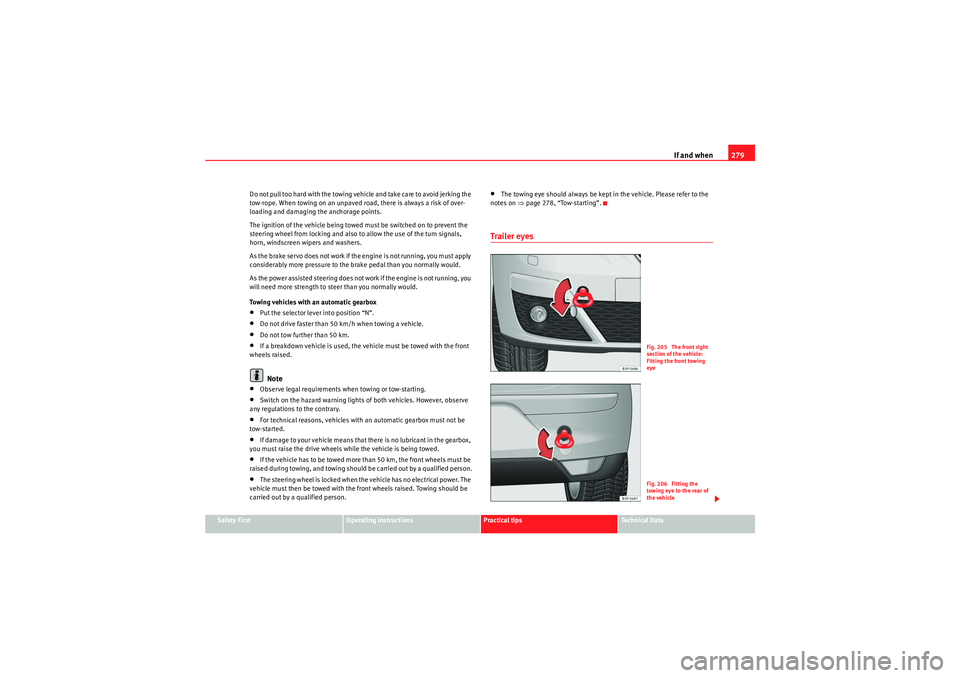
If and when279
Safety First
Operating instructions
Practical tips
Technical Data
Do not pull too hard with the towing vehicle and take care to avoid jerking the
tow-rope. When towing on an unpaved road, there is always a risk of over-
loading and damaging the anchorage points.
The ignition of the vehicle being towed must be switched on to prevent the
steering wheel from locking and also to allow the use of the turn signals,
horn, windscreen wipers and washers.
As the brake servo does not work if the engine is not running, you must apply
considerably more pressure to the brake pedal than you normally would.
As the power assisted steering does not work if the engine is not running, you
will need more strength to steer than you normally would.
Towing vehicles with an automatic gearbox
•Put the selector lever into position “N”.•Do not drive faster than 50 km/h when towing a vehicle.•Do not tow further than 50 km.•If a breakdown vehicle is used, the vehicle must be towed with the front
wheels raised.Note
•Observe legal requirements when towing or tow-starting.•Switch on the hazard warning lights of both vehicles. However, observe
any regulations to the contrary.•For technical reasons, vehicles with an automatic gearbox must not be
tow-started.•If damage to your vehicle means that there is no lubricant in the gearbox,
you must raise the drive wheels while the vehicle is being towed.•If the vehicle has to be towed more than 50 km, the front wheels must be
raised during towing, and towing should be carried out by a qualified person.•The steering wheel is locked when the vehicle has no electrical power. The
vehicle must then be towed with the front wheels raised. Towing should be
carried out by a qualified person.
•The towing eye should always be kept in the vehicle. Please refer to the
notes on ⇒ page 278, “Tow-starting”.Trailer eyes
Fig. 205 The front right
section of the vehicle:
Fitting the front towing
eyeFig. 206 Fitting the
towing eye to the rear of
the vehicle
altea_EN Seite 279 Mittwoch, 26. August 2009 6:00 18
Page 283 of 310
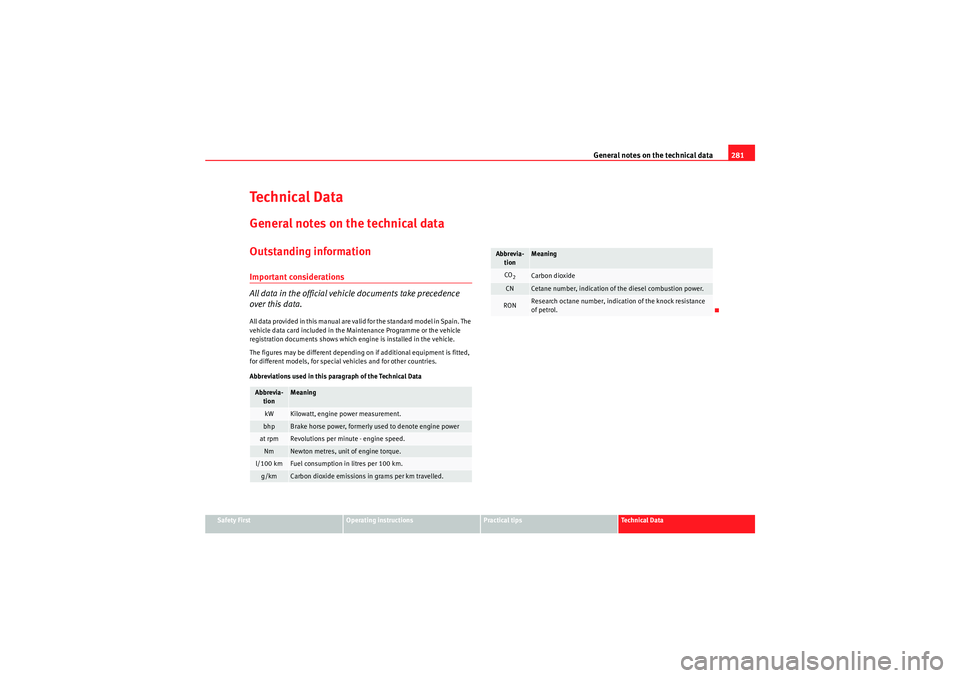
General notes on the technical data281
Safety First
Operating instructions
Practical tips
Technical Data
Te c h n i c a l D a t aGeneral notes on the technical dataOutstanding informationImportant considerations
All data in the official vehicle documents take precedence
over this data.All data provided in this manual are valid for the standard model in Spain. The
vehicle data card included in the Maintenance Programme or the vehicle
registration documents shows which engine is installed in the vehicle.
The figures may be different depending on if additional equipment is fitted,
for different models, for special vehicles and for other countries.
Abbreviations used in this paragraph of the Technical DataAbbrevia-
tion
Meaning
kW
Kilowatt, engine power measurement.
bhp
Brake horse power, formerly used to denote engine power
at rpm
Revolutions per minute - engine speed.
Nm
Newton metres, unit of engine torque.
l/100 km
Fuel consumption in litres per 100 km.
g/km
Carbon dioxide emissions in grams per km travelled.
CO2
Carbon dioxide
CN
Cetane number, indication of the diesel combustion power.
RON
Research octane number, indication of the knock resistance
of petrol.
Abbrevia- tion
Meaning
altea_EN Seite 281 Mittwoch, 26. August 2009 6:00 18
Page 284 of 310
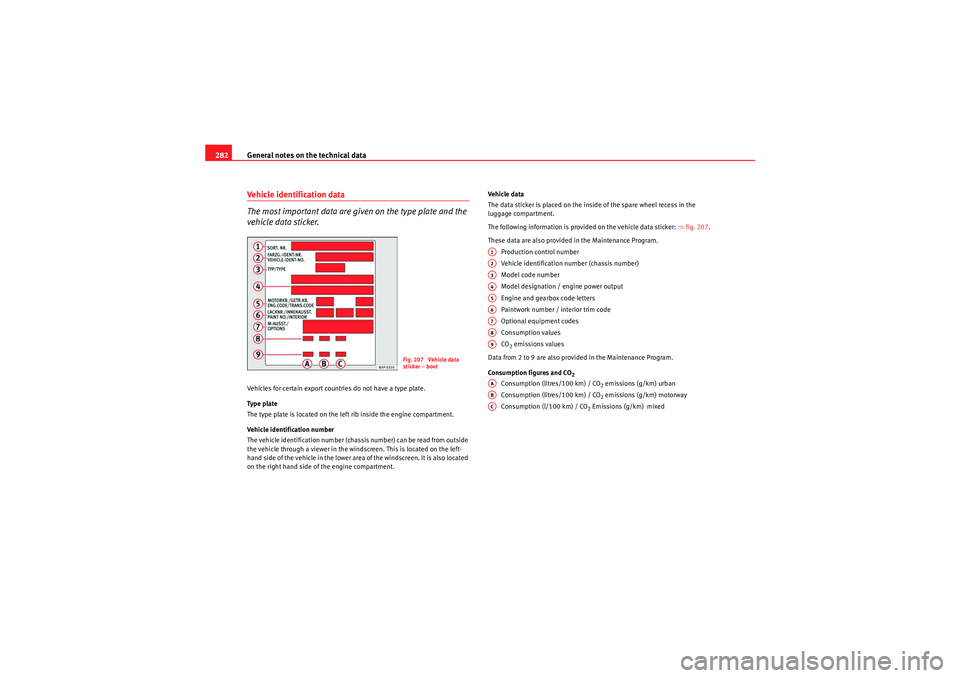
General notes on the technical data
282Vehicle identification data
The most important data are given on the type plate and the
vehicle data sticker.Vehicles for certain export countries do not have a type plate.
Type plate
The type plate is located on the left rib inside the engine compartment.
Vehicle identification number
The vehicle identification number (chassis number) can be read from outside
the vehicle through a viewer in the windscreen. This is located on the left-
hand side of the vehicle in the lower area of the windscreen. It is also located
on the right hand side of the engine compartment. Vehicle data
The data sticker is placed on the inside of the spare wheel recess in the
luggage compartment.
The following information is provided on the vehicle data sticker:
⇒fig. 207.
These data are also provided in the Maintenance Program. Production control number
Vehicle identification number (chassis number)
Model code number
Model designation / engine power output
Engine and gearbox code letters
Paintwork number / interior trim code
Optional equipment codes
Consumption values
CO
2 emissions values
Data from 2 to 9 are also provided in the Maintenance Program.
Consumption figures and CO
2
Consumption (litres/100 km) / CO
2 emissions (g/km) urban
Consumption (litres/100 km) / CO2 emissions (g/km) motorway
Consumption (l/100 km) / CO
2 Emissions (g/km) mixed
Fig. 207 Vehicle data
sticker – boot
A1A2A3A4A5A6A7A8A9AAABAC
altea_EN Seite 282 Mittwoch, 26. August 2009 6:00 18
Page 285 of 310
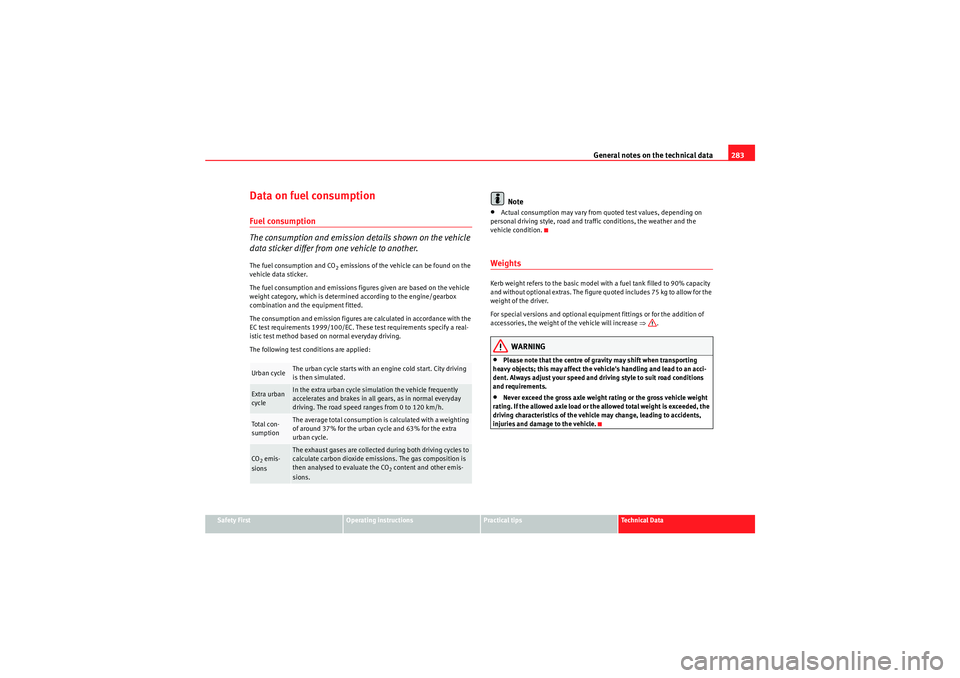
General notes on the technical data283
Safety First
Operating instructions
Practical tips
Technical Data
Data on fuel consumptionFuel consumption
The consumption and emission details shown on the vehicle
data sticker differ from one vehicle to another.The fuel consumption and CO
2 emissions of the vehicle can be found on the
vehicle data sticker.
The fuel consumption and emissions figures given are based on the vehicle
weight category, which is determined according to the engine/gearbox
combination and the equipment fitted.
The consumption and emission figures are calculated in accordance with the
EC test requirements 1999/100/EC. These test requirements specify a real-
istic test method based on normal everyday driving.
The following test conditions are applied:
Note
•Actual consumption may vary from quoted test values, depending on
personal driving style, road and traffic conditions, the weather and the
vehicle condition.WeightsKerb weight refers to the basic model with a fuel tank filled to 90% capacity
and without optional extras. The figure quoted includes 75 kg to allow for the
weight of the driver.
For special versions and optional equipment fittings or for the addition of
accessories, the weight of the vehicle will increase ⇒.
WARNING
•Please note that the centre of gravity may shift when transporting
heavy objects; this may affect the vehicle's handling and lead to an acci-
dent. Always adjust your speed and driving style to suit road conditions
and requirements.•Never exceed the gross axle weight rating or the gross vehicle weight
rating. If the allowed axle load or the allowed total weight is exceeded, the
driving characteristics of the vehicle may change, leading to accidents,
injuries and damage to the vehicle.
Urban cycle
The urban cycle starts with an engine cold start. City driving
is then simulated.
Extra urban
cycle
In the extra urban cycle simulation the vehicle frequently
accelerates and brakes in all gears, as in normal everyday
driving. The road speed ranges from 0 to 120 km/h.
Total con-
sumption
The average total consumption is calculated with a weighting
of around 37% for the urban cycle and 63% for the extra
urban cycle.
CO2 emis-
sions
The exhaust gases are collected during both driving cycles to
calculate carbon dioxide emissions. The gas composition is
then analysed to evaluate the CO
2 content and other emis-
sions.
altea_EN Seite 283 Mittwoch, 26. August 2009 6:00 18
Page 286 of 310
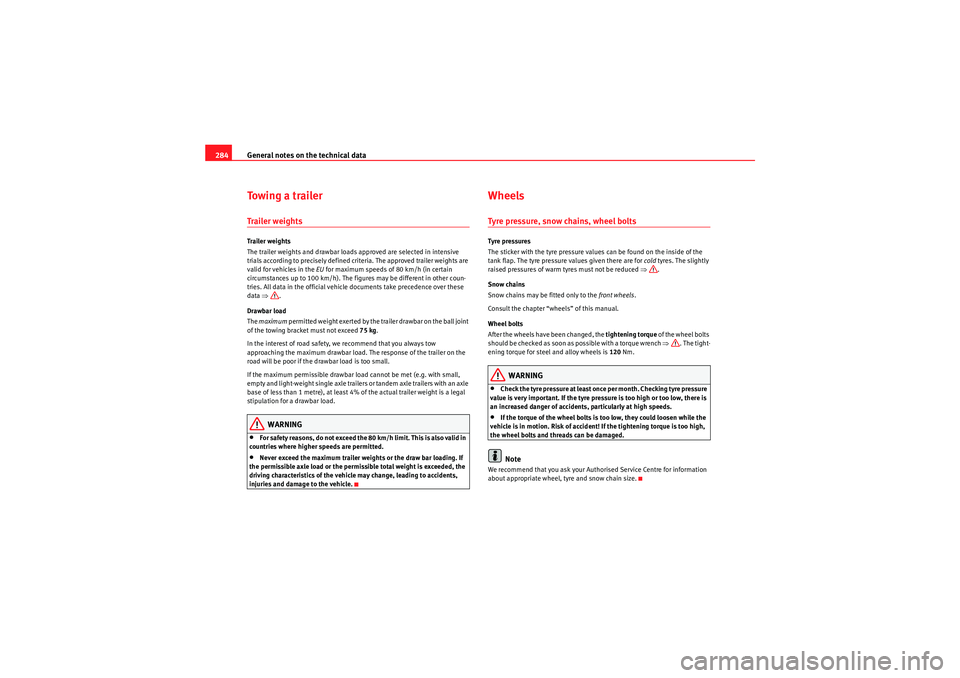
General notes on the technical data
284Towing a trailerTrailer weightsTrailer weights
The trailer weights and drawbar loads approved are selected in intensive
trials according to precisely defined cr iteria. The approved trailer weights are
valid for vehicles in the EU for maximum speeds of 80 km/h (in certain
circumstances up to 100 km/h). The figures may be different in other coun-
tries. All data in the official vehicle documents take precedence over these
data ⇒ .
Drawbar load
The maximum permitted weight exerted by the trailer drawbar on the ball joint
of the towing bracket must not exceed 75 kg.
In the interest of road safety, we recommend that you always tow
approaching the maximum drawbar load. The response of the trailer on the
road will be poor if the drawbar load is too small.
If the maximum permissible drawbar load cannot be met (e.g. with small,
empty and light-weight single axle trailers or tandem axle trailers with an axle
base of less than 1 metre), at least 4% of the actual trailer weight is a legal
stipulation for a drawbar load.
WARNING
•For safety reasons, do not exceed the 80 km/h limit. This is also valid in
countries where higher speeds are permitted.•Never exceed the maximum trailer weights or the draw bar loading. If
the permissible axle load or the permissible total weight is exceeded, the
driving characteristics of the vehicle may change, leading to accidents,
injuries and damage to the vehicle.
WheelsTyre pressure, snow chains, wheel boltsTyre pressures
The sticker with the tyre pressure values can be found on the inside of the
tank flap. The tyre pressure values given there are for cold tyres. The slightly
raised pressures of warm tyres must not be reduced ⇒.
Snow chains
Snow chains may be fitted only to the front wheels.
Consult the chapter “wheels” of this manual.
Wheel bolts
After the wheels have been changed, the tightening torque of the wheel bolts
should be checked as soon as possible with a torque wrench ⇒. The tight-
ening torque for steel and alloy wheels is 120 Nm.
WARNING
•Check the tyre pressure at least once per month. Checking tyre pressure
value is very important. If the tyre pres sure is too high or too low, there is
an increased danger of accidents, particularly at high speeds.•If the torque of the wheel bolts is too low, they could loosen while the
vehicle is in motion. Risk of accident! If the tightening torque is too high,
the wheel bolts and threads can be damaged.Note
We recommend that you ask your Authorised Service Centre for information
about appropriate wheel, tyre and snow chain size.
altea_EN Seite 284 Mittwoch, 26. August 2009 6:00 18
Page 287 of 310
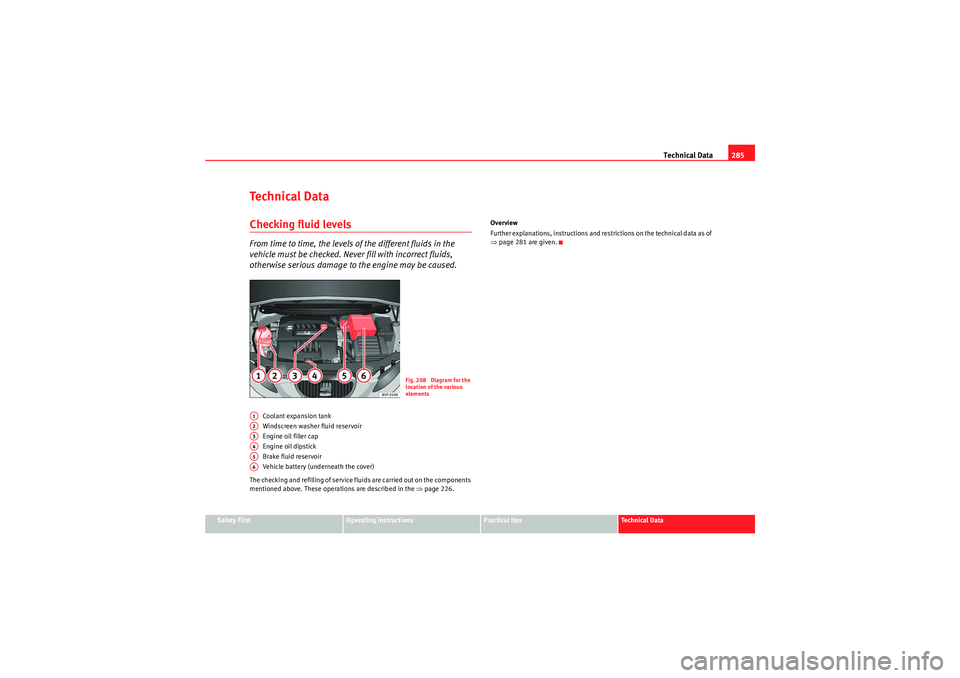
Technical Data285
Safety First
Operating instructions
Practical tips
Technical Data
Te ch n i c a l D a t aChecking fluid levelsFrom time to time, the levels of the different fluids in the
vehicle must be checked. Never fill with incorrect fluids,
otherwise serious damage to the engine may be caused.
Coolant expansion tank
Windscreen washer fluid reservoir
Engine oil filler cap
Engine oil dipstick
Brake fluid reservoir
Vehicle battery (underneath the cover)
The checking and refilling of service fluids are carried out on the components
mentioned above. These operations are described in the ⇒page 226. Overview
Further explanations, instructions and restrictions on the technical data as of
⇒
page 281 are given.
Fig. 208 Diagram for the
location of the various
elements
A1A2A3A4A5A6
altea_EN Seite 285 Mittwoch, 26. August 2009 6:00 18
Page 288 of 310
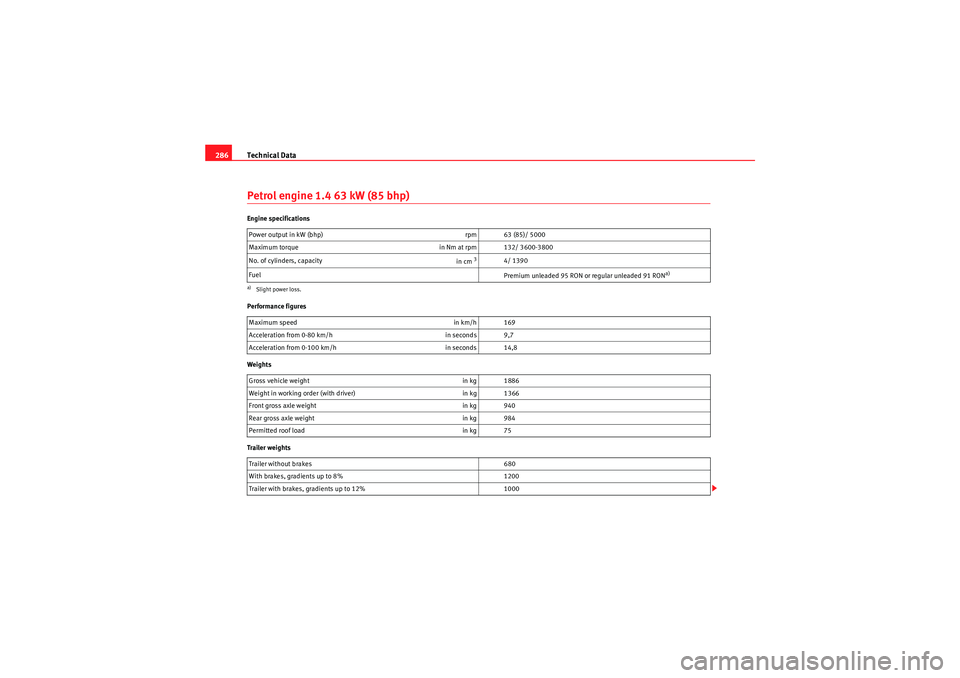
Technical Data
286Petrol engine 1.4 63 kW (85 bhp)Engine specifications
Performance figures
Weights
Trailer weights Power output in kW (bhp)
rpm 63 (85)/ 5000
Maximum torque in Nm at rpm 132/ 3600-3800
No. of cylinders, capacity in cm
3
4/ 1390
Fuel Premium unleaded 95 RON or regular unleaded 91 RON
a)
a)Slight power loss.Maximum speedin km/h 169
Acceleration from 0-80 km/h in seconds 9,7
Acceleration from 0-100 km/h in seconds 14,8
Gross vehicle weight in kg 1886
Weight in working order (with driver) in kg 1366
Front gross axle weight in kg 940
Rear gross axle weight in kg 984
Permitted roof load in kg 75
Trailer without brakes 680
With brakes, gradients up to 8% 1200
Trailer with brakes, gradients up to 12% 1000
altea_EN Seite 286 Mittwoch, 26. August 2009 6:00 18
Page 289 of 310
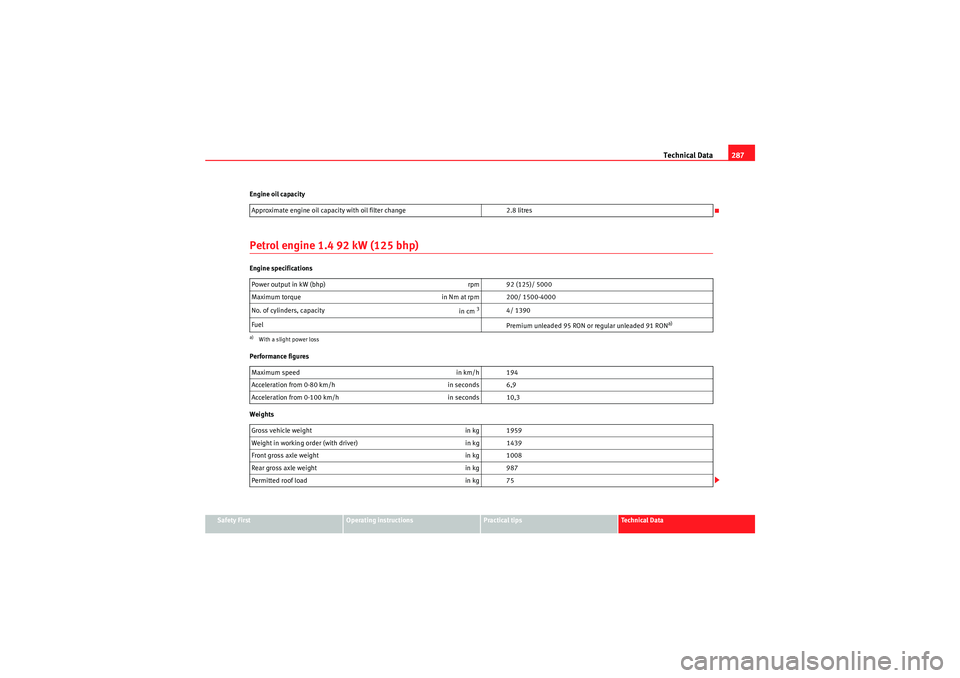
Technical Data287
Safety First
Operating instructions
Practical tips
Technical Data
Engine oil capacity
Petrol engine 1.4 92 kW (125 bhp)Engine specifications
Performance figures
Weights
Approximate engine oil capacity with oil filter change
2.8 litres
Power output in kW (bhp) rpm 92 (125)/ 5000
Maximum torque in Nm at rpm 200/ 1500-4000
No. of cylinders, capacity in cm
3
4/ 1390
Fuel Premium unleaded 95 RON or regular unleaded 91 RON
a)
a)With a slight power lossMaximum speedin km/h 194
Acceleration from 0-80 km/h in seconds 6,9
Acceleration from 0-100 km/h in seconds 10,3
Gross vehicle weight in kg 1959
Weight in working order (with driver) in kg 1439
Front gross axle weight in kg 1008
Rear gross axle weight in kg 987
Permitted roof load in kg 75
altea_EN Seite 287 Mittwoch, 26. August 2009 6:00 18
Page 290 of 310
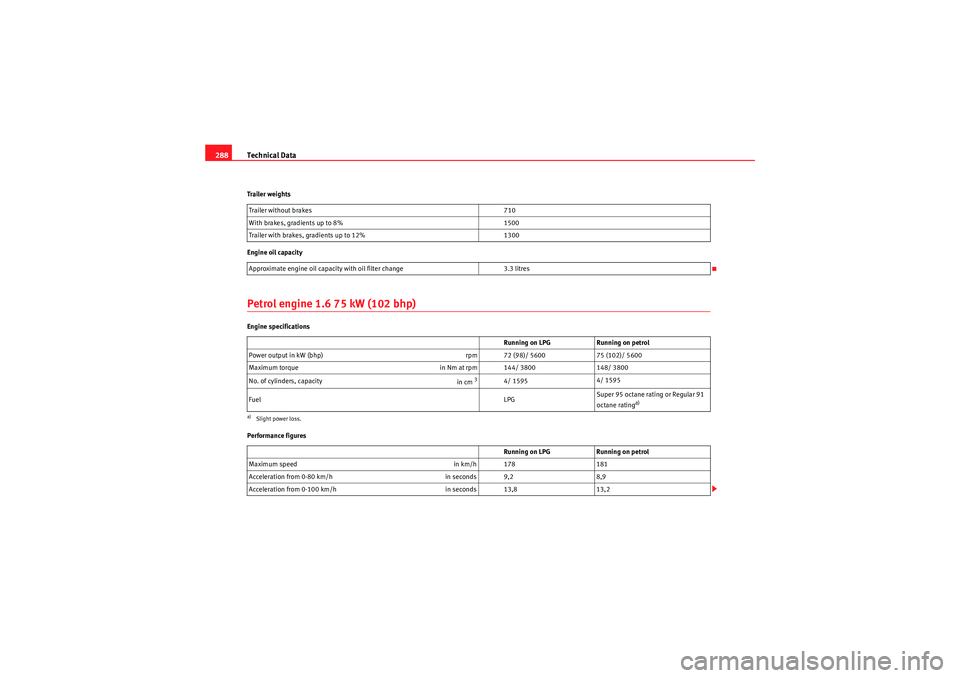
Technical Data
288Trailer weights
Engine oil capacityPetrol engine 1.6 75 kW (102 bhp)Engine specifications
Performance figures Trailer without brakes
710
With brakes, gradients up to 8% 1500
Trailer with brakes, gradients up to 12% 1300
Approximate engine oil capacity with oil filter change 3.3 litres
Running on LPG Running on petrol
Power output in kW (bhp) rpm 72 (98)/ 560075 (102)/ 5600
Maximum torque in Nm at rpm 144/ 3800148/ 3800
No. of cylinders, capacity in cm
3
4/ 15954/ 1595
Fuel LPGSuper 95 octane rating or Regular 91
octane rating
a)
a)Slight power loss.
Running on LPG
Running on petrol
Maximum speed in km/h 178181
Acceleration from 0-80 km/h in seconds 9,28,9
Acceleration from 0-100 km/h in seconds 13,813,2
altea_EN Seite 288 Mittwoch, 26. August 2009 6:00 18
Page 291 of 310
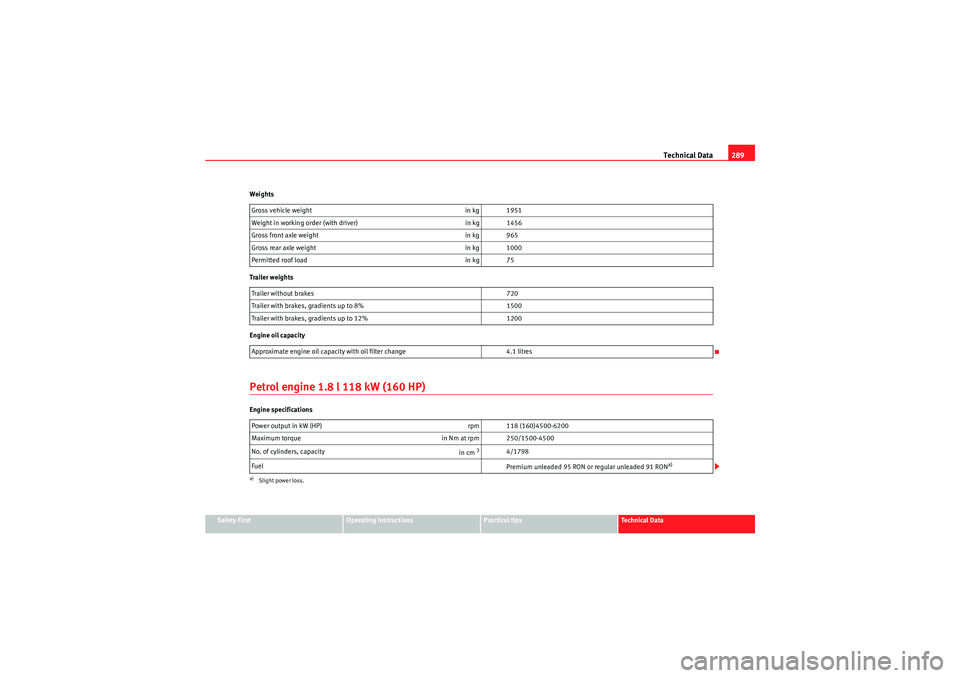
Technical Data289
Safety First
Operating instructions
Practical tips
Technical Data
Weights
Trailer weights
Engine oil capacity
Petrol engine 1.8 l 118 kW (160 HP)Engine specifications
Gross vehicle weight
in kg 1951
Weight in working order (with driver) in kg 1456
Gross front axle weight in kg 965
Gross rear axle weight in kg 1000
Permitted roof load in kg 75
Trailer without brakes 720
Trailer with brakes, gradients up to 8% 1500
Trailer with brakes, gradients up to 12% 1200
Approximate engine oil capacity with oil filter change 4.1 litres
Power output in kW (HP) rpm 118 (160)4500-6200
Maximum torque in Nm at rpm 250/1500-4500
No. of cylinders, capacity in cm
3
4/1798
Fuel Premium unleaded 95 RON or regular unleaded 91 RON
a)
a)Slight power loss.
altea_EN Seite 289 Mittwoch, 26. August 2009 6:00 18